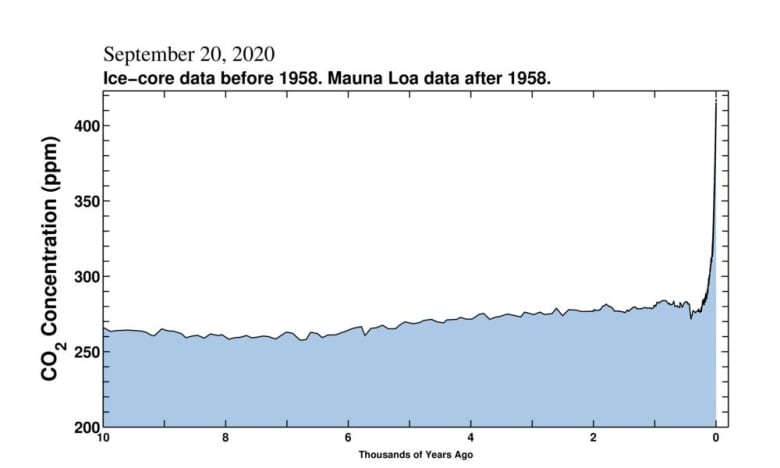Science
2020 could be on track to be another record-setting warm year, despite global lockdowns – CBC.ca

People around the world participated in the Global Day of Climate Action on Friday, a reminder that even though we’re in the midst of one of the biggest health issues to face humanity, climate change stands to pose an even bigger threat — with increased chances of drought, wildfires, hurricanes, flooding and heat waves.
At the start of the COVID-19 pandemic earlier this year, businesses shuttered and people went into lockdown. As a result, greenhouse gas emissions dropped, including both nitrogen dioxide and carbon dioxide (CO2), two drivers of global warming.
There was some hope that this could be the silver lining to a tragic situation, but the fact is, it’s unlikely to make a dent in the upward trend of Earth’s rising temperatures.
In fact, the U.S. National Atmospheric and Oceanic Administration’s National Centers for Environmental Information (NCEI) recorded that globally, August’s land and sea temperatures were the second-highest on record. For North America, it was the hottest August on record, at 1.52 C above average. August also marked the 428th-consecutive month with temperatures above the 20th-century average.
The issue is that CO2 has already accumulated in our atmosphere, and Earth is playing a game of catch-up.
“Carbon dioxide can last thousands and thousands of years in the atmosphere,” said Ahira Sanchez-Lugo, a physical scientist who compiles global temperature data at NCEI. “So just because with the pandemic we’ve seen a reduction in emissions, that doesn’t mean that we will see a reduction in global temperatures any time soon.”
Climatologist Michael Mann, a professor of atmospheric science at Penn State University, said there’s likely to be a drop in emissions but that it won’t make a large difference.
“It will probably lead to a roughly four to five per cent reduction in carbon emissions for 2020. That means a very slightly lower rate of warming,” he said.
Too many blankets
Sanchez-Lugo likes to use the analogy of CO2 acting as Earth’s blanket: It’s needed in order to regulate the planet’s temperature, but additional accumulation is like throwing more and more blankets on top.
“So that’s what’s happening right now in that sense: Right now, Earth already has several layers of blankets, and just because we stopped or we’ve reduced carbon greenhouse emissions recently, that doesn’t mean that we’re peeling off those blankets,” she said.
Year-to-date, the temperature is 1.03 C higher than the average and is only behind 2016’s record warmth of 1.08 C above average.
The hottest year on record was 2016, reaching 0.94 C above the average. It also marked the third-consecutive year a record was set. But that was also the year of a moderate to strong El Nino, a natural phenomenon that is characterized by warming in the Pacific Ocean — which in turn causes higher temperatures in some regions and greater precipitation in others.
This year, however, has not been a year of El Nino.
So does this mean we might break the 2016 record without its warming effect?
“Right now, there is about a 55 per cent chance of [2020] being the second warmest,” Sanchez-Lugo said, “and … about a 39 per cent chance of it being the warmest year on record.”
While 2020 may not be on top of the list, it’s likely that more and more records will be set in the coming years.


A study published in May in the Bulletin of the American Meteorological Society, of which Sanchez-Lugo was a co-author suggested that “there’s a greater than a 99 per cent chance that most of the next 10 years through 2028 will be ranked among the top 10 warmest.”
The pandemic might be a way of illustrating that countries can reduce their emissions by altering their lifestyles, such as by not commuting to work five days a week, which would be one way to continue to see emissions decrease.
But Mann said big changes need to be made in order to see significant improvement in the decades to come.
“If we can reduce carbon emissions a bit more — about seven per cent a year — for each of the next 10 years, we can stay on a path that stabilizes global warming below 1.5 C, preventing the most damaging and dangerous impacts of climate change,” he said.
“However, simple behavioural changes won’t get us there. We need systematic change, i.e. policies to rapidly decarbonize our economy.”
Science
Record breaker! Milky Way's most monstrous stellar-mass black hole is sleeping giant lurking close to Earth (Video) – Space.com


The Milky Way has a big newfound black hole, and it lurks close to Earth! This sleeping giant was discovered with the European space telescope Gaia, which tracks the motion of billions of stars in our galaxy.
Stellar-mass black holes are created when a large star runs out of fuel and collapses. The new discovery is a landmark, representing the first time that a big black hole with such an origin has been found close to Earth.
The stellar-mass black hole, designated Gaia-BH3, is 33 times more massive than our sun. The previous most massive black hole of this class found in the Milky Way was a black hole in an X-ray binary in the Cygnus constellation (Cyg X-1), whose mass is estimated to be around 20 times that of the sun. The average stellar-mass black hole in the Milky Way is about 10 times heftier than the sun.
Gaia-BH3 is located just 2,000 light years from Earth, making it the second-closest black hole to our planet ever discovered. The closest black hole to Earth is Gaia-BH1 (also discovered by Gaia), which is 1,560 light-years away. Gaia-BH1 has a mass around 9.6 times that of the sun, making it considerably smaller than this newly discovered black hole.
“Finding Gaia BH3 is like the moment in the film ‘The Matrix’ where Neo starts to ‘see’ the matrix,” George Seabrook, a scientist at Mullard Space Science Laboratory at University College London and a member of Gaia’s Black Hole Task Force, said in a statement sent to Space.com. “In our case, ‘the matrix’ is our galaxy’s population of dormant stellar black holes, which were hidden from us before Gaia detected them.”
Seabroke added that Gaia BH3 is an important clue to this population, because it is the most massive stellar black hole found in our galaxy.
Of course, Gaia-BH3 is a small fry compared to the supermassive black hole that dominates the heart of the Milky Way, Sagittarius A* (Sgr A*), which has a mass 4.2 million times that of the sun. Supermassive black holes like Sgr A* aren’t created by the deaths of massive stars but rather by mergers of progressively larger and larger black holes.
Sleeping giant black hole caused stellar companion to throw a wobbly
All black holes are marked by an outer boundary called an event horizon, at which point the black hole’s escape velocity exceeds the speed of light. That means an event horizon is a one-way light-trapping surface beyond which no information can escape.
As a result, black holes don’t emit or reflect light, meaning they can only be “seen” when they are surrounded by material that they gradually feed on. Sometimes, this means a black hole in a binary system pulling material from a companion star, which forms a disk of gas and dust around it.
The tremendous gravitational influence of black holes generates intense tidal forces in this surrounding matter, causing it to glow brightly with material that is destroyed and consumed, also emitting X-rays. Additionally, the material the black hole doesn’t feast on can be channeled to its poles and blasted out as near-light speed jets, which are accompanied by the emission of light.
All of these light emissions can allow astronomers to spot black holes. The question is, how can “dormant” black holes that aren’t feeding on gas and dust around them be detected? For instance, what if a stellar-mass black hole has a companion star, but the two are too widely separated for the black hole to snatch stellar matter from its binary partner?
In cases like this, the black hole and its companion star orbit a point that represents the system’s center of mass. This is also the case when a star is orbited by a light companion, such as another star or even a planet.
Orbiting the center of mass results in a wobble in the motion of the star, which is visible to astronomers. Because Gaia is adept at precisely measuring the motion of stars, it is the ideal instrument to see this wobble.
Gaia’s Black Hole Task Force set about looking for odd wobbles that couldn’t be accounted for by the presence of another star or a planet and that indicated a heavier companion, possibly a black hole.


Homing in on an old giant star in the constellation Aquila, located 1,926 light-years from Earth, the team found a wobble in the star’s path. That wobble suggests that the star is locked in orbital motion with a dormant black hole of exceptionally high mass. The two are separated by a distance that ranges from the distance between the sun and Neptune at their widest and our star and Jupiter at their closest.
“It’s a real unicorn,” lead researcher Pasquale Panuzzo of CNRS, Observatoire de Paris in France, said in a statement. “This is the kind of discovery you make once in your research life. So far, black holes this big have only ever been detected in distant galaxies by the LIGO-Virgo-KAGRA collaboration, thanks to observations of gravitational waves.”
Related: What are gravitational waves?


Thanks to the sensitivity of Gaia, the Black Hole Task Force was also able to put constraints on the mass of Gaia-BH3, finding it to possess 33 solar masses.
“Gaia-BH3 is the very first black hole for which we could measure the mass so accurately,” said Tsevi Mazeh, a scientist and Gaia collaboration member at Tel Aviv University. “At 30 times that of our sun, the object’s mass is typical of the estimates we have for the masses of the very distant black holes observed by gravitational wave experiments. Gaia’s measurements provide the first undisputable proof that [stellar-mass] black holes this heavy do exist.”
RELATED STORIES:
However, the Gaia-BH3 system is bound to be of great interest to scientists for more than just its proximity to Earth and the mass of its black hole.
The star in this system is a sub-giant star that is around five times as large as the sun with 15 times its brightness, though it is cooler and less dense than our star. The Gaia-BH3 companion star is mainly composed of hydrogen and helium, the universe’s two lightest elements, lacking heavier elements, which astronomers (somewhat confusingly) call “metals.”
The fact that this star is “metal-poor” suggests that the star that collapsed and died to create Gaia-BH3 also lacked heavier elements. Metal-poor stars are expected to shed more mass than their more metal-rich counterparts during their lives, so scientists have questioned if they can maintain enough mass to birth black holes. Gaia-BH3 represents the first hint that metal-poor stars can indeed do so.
“Gaia’s next data release is expected to contain many more, which should help us to ‘see’ more of ‘the matrix’ and to understand how dormant stellar black holes form,” Seabroke concluded.
The team’s research was published today (April 16) in the journal Astronomy & Astrophysics.
Science
Nasa confirms metal chunk that crashed into Florida home was space junk


|
|
A heavy chunk of metal that crashed through the roof of a Florida home is, in fact, space junk, Nasa has confirmed.
The federal space agency said that a cylinder slab that tore through a house in Naples, Florida, last month was debris from a cargo pallet released from the international space station in 2021, according to a Nasa blogpost.
The determination was made after the agency collected the debris from the Florida home and analyzed it at the Kennedy Space Center.
“Based on the examination, the agency determined the debris to be a stanchion from the Nasa flight support equipment used to mount the batteries on the cargo pallet,” the agency said.
The pallet, which contained ageing nickel hydride batteries, was released after new lithium-ion batteries were installed in the space station.
The debris was supposed to be destroyed in the Earth’s atmosphere. Instead, a piece of metal crashed through a Florida home, NBC News reported.
The debris weighs 1.6lb and measures about 4in by 1.6in.
Homeowner Alejandro Otero described the experience to WINK News, which first reported the story.
“It was a tremendous sound. It almost hit my son. He was two rooms over and heard it all,” Otero said to WINK.
“Something ripped through the house and then made a big hole on the floor and on the ceiling.”
The scientific journal Ars Technica previously speculated that the metal was probably space station debris. Nasa finally confirmed the origin of the chunk on Monday.
The space agency added that it would investigate how the debris managed to survive its re-entry into Earth’s atmosphere and “update modeling and analysis”.
It is unclear if Nasa will cover the cost of damages to Otero’s home.
In comments posted to X shortly after the incident, Otero said that Nasa had not responded to messages he left with the agency.





Science
Federal government announces creation of National Space Council – CBC News


Canada’s space sector received a boost from the federal government in its budget, both in terms of money and vision.
The 2024 budget included a proposal for $8.6 million in 2024-25 to the Canadian Space Agency (CSA) for the Lunar Exploration Accelerator Program (LEAP), which invests in technologies for humanity’s return to the moon and beyond.
In addition to the funding, the federal government also announced the creation of a National Space Council, which will be “a new whole-of-government approach to space exploration, technology development, and research.”
For Space Canada, an organization comprised of roughly 80 space sector companies including some of Canada’s largest, such as Magellan Aerospace, Maritime Launch and MDA, it was a welcome announcement.
“We’ve been advocating for it since the inception of our organization, and we were really very happy, and we applaud the federal government’s commitment announced in the budget,” said Brian Gallant, CEO of Space Canada.
Gallant said that investment in space is an investment in Canada.
“Two-thirds of space sector jobs are STEM jobs. These are good paying solid jobs for Canadians. And on top of that, we have approximately $2.8 billion that is injected into the Canadian economy because of the space sector,” he said.
The U.S. formed its National Space Council in 1989, but it was disbanded in 1992 and reestablished in 2017.
In the 2023 budget, the government announced proposed spending of $1.2 billion over 13 years, that was to begin in 2024-25, to the CSA’s contribution of a lunar utility vehicle that would assist astronauts on the moon. The as–yet–developed vehicle could help astronauts move cargo from landing sites to habitats, perform science investigations or support them during spacewalks on the surface of the moon.
It also proposed to invest $150 million over five years for the LEAP program.
MDA, the company behind Canadarm, was also pleased with the announcement.
“Canada has an enviable global competitive advantage in space and the creation of a National Space Council is critical to Canada maintaining that leadership position,” CEO Mike Greenley said in an email to CBC News.
“Space is now a rapidly growing, highly strategic and competitive domain, and there is a real and urgent need to recognize its importance to the lives of Canadians and to our economy and national security.”
The next project for MDA is Canadarm3, which will be part of Lunar Gateway, a international space station that will orbit the moon. It will serve as a sort of jumping-off point for astronauts heading to the moon and eventually beyond.
“The Lunar Gateway is a great opportunity for Canada and for MDA Space to not only provide the next generation of Canadarm robotics but to clearly plant our flag as a core national and industry participant in the Artemis era,” Greenley said.
Lunar Gateway is set to begin construction no earlier than 2025, according to NASA.
-



 Sports21 hours ago
Sports21 hours agoTeam Canada’s Olympics looks designed by Lululemon
-
News22 hours ago
Richard Chevolleau Short Film “Marvelous Marvin” Set to go to Camera
-
Business20 hours ago
Firefighters battle wildfire near Edson, Alta., after natural gas line rupture – CBC.ca
-



 Tech13 hours ago
Tech13 hours agoiPhone 15 Pro Desperado Mafia model launched at over ₹6.5 lakh- All details about this luxury iPhone from Caviar – HT Tech
-



 Investment23 hours ago
Investment23 hours agoStephen Poloz will lead push to boost domestic investment by Canadian pension funds
-
News23 hours ago
Federal budget 2024: Some of the winners and losers
-



 Sports13 hours ago
Sports13 hours agoLululemon unveils Canada's official Olympic kit for the Paris games – National Post
-



 Investment21 hours ago
Investment21 hours agoWall Street bosses cheer investment banking gains but stay cautious




